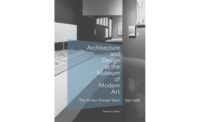In this book of essays, Michelangelo Sabatino writes, “With the exception of the Rothko Chapel, a design by Philip Johnson that Barnstone & Aubry modified to satisfy Mark Rothko, [Howard] Barnstone’s work never entered the canon of iconic Houston modern buildings.” Yet the story of this man, and his work, little known outside of Texas, fills this Texas-sized tome with a rich history of 20th-century architecture and its patronage, the complex personal struggles of an “outsider” architect and individual, and stunning archival photography of the inventive buildings and interiors he designed. Those designs, so rooted in their time and place but with universal appeal, deserve, at long last, a larger audience.
Barnstone, who was also an author and educator, did, nonetheless, enjoy renown during his career, which spanned 40 years, from the late 1940s to his death in 1987. He was considered Houston’s foremost modern architect in the 1950s; RECORD’s editors published his work several times up to the 1970s, putting the Gordon House (PDF), by Bolton & Barnstone, on the cover of its annual Record Houses issue in 1956. He also hobnobbed with Houston society, essentially becoming John and Dominique de Menil’s in-house architect, providing design services for the family’s Schlumberger corporation and their extended family and friends. Notably, in 1961, Barnstone added a barrel-vaulted canopy over the courtyard of John and Dominique’s house, another building by Philip Johnson (1951) that he worked on.
Johnson was indeed a central figure in Barnstone’s career. Like the New York–based architect, Barnstone adopted early on the rigorous architectural practices of Mies van der Rohe. About Barnstone’s buildings, mainly houses, Stephen Fox writes, “they demonstrate amazing consistency in their spatiality, proportions, scale, indoor-outdoor relationships, use of transparency, and details.” Sadly, some of these have been demolished by now, including the razing just last year of one of his larger projects, the sculpturally dramatic six-building Harris County Center for the Retarded (1966), as it was originally known. Barnstone resisted Postmodernism until Johnson posed with his model of the AT&T building on the cover of Time magazine in 1979. But Barnstone’s later work received less attention, and the recession of the 1980s hit Houston, and Barnstone, hard.
While the book’s three editors admit most surveys of architects’ careers make only minimal reference to their personal lives, they point out that Barnstone was haunted by inner demons. He was a Jewish man living in the South, and bisexual—though he denied it—married for many years to Gertrude Levy, an actress, artist, and vocal political activist who sometimes overshadowed him. Like his father, Barnstone suffered from bipolar disorder. His divorce in 1968 triggered a severe bipolar episode; the treatment included electroconvulsive therapy. A similar episode, beginning in 1985, ultimately led to his suicide by overdose of sleeping pills in 1987. His funeral was held at the Rothko Chapel.
Barnstone readily admitted he had little to do with the design of the chapel, despite frequent meetings with Mark Rothko that involved lots of drinking and commiserating. The artist never saw it installed with his suite of 14 brooding paintings. Like Barnstone, he committed suicide in his mid-60s—a year before the building was completed in 1971. It reopens in September after a comprehensive restoration by New York–based Architecture Research Office (ARO). Says ARO principal Adam Yarinsky, “The chapel’s matter-of-fact construction and unfenestrated brick exterior belie the unexpected experiential intensity within.” That a simple exterior could mask such revelations inside is something that applies to much of Barnstone’s work, and to the man himself.








Post a comment to this article
Report Abusive Comment